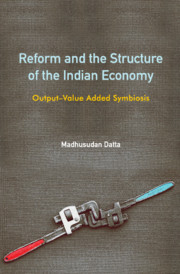Book contents
- Frontmatter
- Dedication
- Contents
- Tables
- Figures and Box
- Preface
- 1 Introduction: The Take-off
- 2 Growth and Structural Change since 1978–79: Issues in Measurement
- 3 Sectoral Shares in Indian GDP: How to Regard It?
- 4 Sectoral Growth: GVA–Output Dichotomy
- 5 Manufacturing Sector in the Indian Economy: Paradox of Growth and Stagnation
- 6 Growth and Sectoral GVA Adjustments
- 7 Demand for Intermediate Services
- 8 Linkages and Key Sectors in the Indian Economy
- 9 Conclusion: A Perspective of Indian Economic Growth
- References
- Index
Preface
Published online by Cambridge University Press: 17 March 2020
- Frontmatter
- Dedication
- Contents
- Tables
- Figures and Box
- Preface
- 1 Introduction: The Take-off
- 2 Growth and Structural Change since 1978–79: Issues in Measurement
- 3 Sectoral Shares in Indian GDP: How to Regard It?
- 4 Sectoral Growth: GVA–Output Dichotomy
- 5 Manufacturing Sector in the Indian Economy: Paradox of Growth and Stagnation
- 6 Growth and Sectoral GVA Adjustments
- 7 Demand for Intermediate Services
- 8 Linkages and Key Sectors in the Indian Economy
- 9 Conclusion: A Perspective of Indian Economic Growth
- References
- Index
Summary
The hallmark of a modern economy is technological change that continuously transforms the existing order. Measurement of economic variables in such a dynamic backdrop poses great challenge to the economic statistician. The nature of the product has been changing as has been the technique or the use of factors of production. That impacts prices of products, but not uniformly. The different sectors of the economy are interlaced but we have the concept of monetary value added by each sector. Value added is easy to measure, but does that quantity show the level of activity of a sector as reflected in its output? The question presumes that we know what real output is; apparently simple concepts with respect to a firm become quite tricky when applied to aggregates. Nevertheless, the question is important for understanding the changing structure of an economy, and that motivated the present study.
Economic growth is essentially a quantitative idea and growth comes hand in hand with changes in industrial structure. So, an analysis of structural change is inevitably data intensive. I have tried to be careful, taken care to go into the nature of data and its consistency with the overall national accounting framework. In a sense, the analysis in the book gives data precedence over prevailing ideas about the development of the Indian economy. Some simple frameworks have been devised to explain the observed trends; the findings, in large part, go against mainstream ideas. Further research will resolve any lingering doubts about my findings.
The basic results of the study have been published in several journals – Applied Economics, Money and Finance, Structural Change and Economic Dynamics (SCED) and Journal of Asian Economics. My teacher Mihir Rakshit read one of my core working papers and suggested a number of improvements that I have incorporated into the work. Improvements have also been suggested by some editors and anonymous referees of the above-mentioned journals and the Cambridge University Press. Soumyen Sikdar provided encouragement at different points in the course of my work. I am grateful to all of them.
The study started, without a conscious plan of a book, with a project and then carried forward by another project, both granted by the Indian Council of Social Science Research (ICSSR).
- Type
- Chapter
- Information
- Reform and the Structure of the Indian EconomyOutput-Value Added Symbiosis, pp. xiii - xviPublisher: Cambridge University PressPrint publication year: 2020



